Antibody data
- Antibody Data
- Antigen structure
- References [104]
- Comments [0]
- Validations
- Immunocytochemistry [2]
- Immunohistochemistry [1]
- Other assay [19]
Submit
Validation data
Reference
Comment
Report error
- Product number
- 71-2200 - Provider product page

- Provider
- Invitrogen Antibodies
- Product name
- Connexin 30 Polyclonal Antibody (Z-PP9)
- Antibody type
- Polyclonal
- Antigen
- Synthetic peptide
- Description
- This antibody is specific for the Connexin 30. Cross-reactivity with the highly related Connexin 26 protein or with other Connexin family members has not been detected. Reactivity of this antibody has been confirmed by western blotting using cell lysates derived from adult rat, mouse, human, and cat brains.
- Reactivity
- Human, Mouse, Rat, Feline
- Host
- Rabbit
- Isotype
- IgG
- Antibody clone number
- Z-PP9
- Vial size
- 50 μg
- Concentration
- 0.25 mg/mL
- Storage
- -20°C
Submitted references Physiological synaptic activity and recognition memory require astroglial glutamine.
Activin/Nodal/TGF-β Pathway Inhibitor Accelerates BMP4-Induced Cochlear Gap Junction Formation During in vitro Differentiation of Embryonic Stem Cells.
Spike Generators and Cell Signaling in the Human Auditory Nerve: An Ultrastructural, Super-Resolution, and Gene Hybridization Study.
Beneficial contribution of induced pluripotent stem cell-progeny to Connexin 47 dynamics during demyelination-remyelination.
Dynamic Spatiotemporal Expression Changes in Connexins of the Developing Primate's Cochlea.
Extensive transcriptional and chromatin changes underlie astrocyte maturation in vivo and in culture.
GJB2 Mutations Linked to Hearing Loss Exhibit Differential Trafficking and Functional Defects as Revealed in Cochlear-Relevant Cells.
Comparative Analysis of Cx31 and Cx43 in Differentiation-Competent Rodent Keratinocytes.
A novel voltage-clamp/dye uptake assay reveals saturable transport of molecules through CALHM1 and connexin channels.
Cisplatin-induced ototoxicity in organotypic cochlear cultures occurs independent of gap junctional intercellular communication.
Neuronal Activity Drives Astroglial Connexin 30 in Perisynaptic Processes and Shapes Its Functions.
Connexin Signaling Is Involved in the Reactivation of a Latent Stem Cell Niche after Spinal Cord Injury.
A potent antagonist antibody targeting connexin hemichannels alleviates Clouston syndrome symptoms in mutant mice.
Degradation and modification of cochlear gap junction proteins in the early development of age-related hearing loss.
Stress gates an astrocytic energy reservoir to impair synaptic plasticity.
Hearing consequences in Gjb2 knock-in mice: implications for human p.V37I mutation.
Early Hearing Loss upon Disruption of Slc4a10 in C57BL/6 Mice.
mCCD(cl1) cells show plasticity consistent with the ability to transition between principal and intercalated cells.
Chronic Unpredictable Stress Reduces Immunostaining for Connexins 43 and 30 and Myelin Basic Protein in the Rat Prelimbic and Orbitofrontal Cortices.
Connexin 30 controls astroglial polarization during postnatal brain development.
Knockout of Pannexin-1 Induces Hearing Loss.
Mouse Panx1 Is Dispensable for Hearing Acquisition and Auditory Function.
Subcellular reorganization and altered phosphorylation of the astrocytic gap junction protein connexin43 in human and experimental temporal lobe epilepsy.
CD38 positively regulates postnatal development of astrocytes cell-autonomously and oligodendrocytes non-cell-autonomously.
Amplification mode differs along the length of the mouse cochlea as revealed by connexin 26 deletion from specific gap junctions.
A connexin30 mutation rescues hearing and reveals roles for gap junctions in cochlear amplification and micromechanics.
Permeant-specific gating of connexin 30 hemichannels.
Molecular composition and distribution of gap junctions in the sensory epithelium of the human cochlea-a super-resolution structured illumination microscopy (SR-SIM) study.
Loss of Panx1 Impairs Mammary Gland Development at Lactation: Implications for Breast Tumorigenesis.
Experimental febrile seizures impair interastrocytic gap junction coupling in juvenile mice.
Connexin gap junction channels and chronic rhinosinusitis.
Differential expression of astrocytic connexins in a mouse model of prenatal alcohol exposure.
Super-resolution structured illumination fluorescence microscopy of the lateral wall of the cochlea: the Connexin26/30 proteins are separately expressed in man.
In Vitro Models of GJB2-Related Hearing Loss Recapitulate Ca(2+) Transients via a Gap Junction Characteristic of Developing Cochlea.
Connexins, E-cadherin, Claudin-7 and β-catenin transiently form junctional nexuses during the post-natal mammary gland development.
Connexin43 and connexin47 alterations after neural precursor cells transplantation in experimental autoimmune encephalomyelitis.
Mice with conditional deletion of Cx26 exhibit no vestibular phenotype despite secondary loss of Cx30 in the vestibular end organs.
Connexin26 gap junction mediates miRNA intercellular genetic communication in the cochlea and is required for inner ear development.
Isoform-specific phosphorylation-dependent regulation of connexin hemichannels.
Cx30 exhibits unique characteristics including a long half-life when assembled into gap junctions.
Pannexin1 channels dominate ATP release in the cochlea ensuring endocochlear potential and auditory receptor potential generation and hearing.
Connexin26 (GJB2) deficiency reduces active cochlear amplification leading to late-onset hearing loss.
Effects of sleep and wake on astrocytes: clues from molecular and ultrastructural studies.
Mammary gland specific knockdown of the physiological surge in Cx26 during lactation retains normal mammary gland development and function.
Evidence for aberrant astrocyte hemichannel activity in Juvenile Neuronal Ceroid Lipofuscinosis (JNCL).
Gap junctional coupling is essential for epithelial repair in the avian cochlea.
Deafness induced by Connexin 26 (GJB2) deficiency is not determined by endocochlear potential (EP) reduction but is associated with cochlear developmental disorders.
The Clouston syndrome mutation connexin30 A88V leads to hyperproliferation of sebaceous glands and hearing impairments in mice.
Expression of gap junction proteins connexins 26, 30, and 43 in Dupuytren's disease.
Connexin 30 sets synaptic strength by controlling astroglial synapse invasion.
Assembly of the cochlear gap junction macromolecular complex requires connexin 26.
Tanshinone IIA increases the bystander effect of herpes simplex virus thymidine kinase/ganciclovir gene therapy via enhanced gap junctional intercellular communication.
Active cochlear amplification is dependent on supporting cell gap junctions.
Connexin dynamics in the privileged wound healing of the buccal mucosa.
Cerebral ischemic injury is enhanced in a model of oculodentodigital dysplasia.
Spatiotemporal changes in Cx30 and Cx43 expression during neuronal differentiation of P19 EC and NT2/D1 cells.
Connexin30-mediated intercellular communication plays an essential role in epithelial repair in the cochlea.
Prostaglandin-induced cervical remodelling in humans in the first trimester is associated with increased expression of specific tight junction, but not gap junction proteins.
Comparison of bidirectional and bicistronic inducible systems for coexpression of connexin genes and fluorescent reporters.
BAAV mediated GJB2 gene transfer restores gap junction coupling in cochlear organotypic cultures from deaf Cx26Sox10Cre mice.
Connexin32 can restore hearing in connexin26 deficient mice.
Functional heterotypic interactions between astrocyte and oligodendrocyte connexins.
Neuroinflammation leads to region-dependent alterations in astrocyte gap junction communication and hemichannel activity.
The connexin26 S17F mouse mutant represents a model for the human hereditary keratitis-ichthyosis-deafness syndrome.
Reduced gap junctional communication among astrocytes in experimental diabetes: contributions of altered connexin protein levels and oxidative-nitrosative modifications.
Ablation of connexin30 in transgenic mice alters expression patterns of connexin26 and connexin32 in glial cells and leptomeninges.
Astroglial connexin immunoreactivity is specifically altered at β-amyloid plaques in β-amyloid precursor protein/presenilin1 mice.
Dominant connexin26 mutants associated with human hearing loss have trans-dominant effects on connexin30.
Hyperglycaemia and diabetes impair gap junctional communication among astrocytes.
ATP-mediated cell-cell signaling in the organ of Corti: the role of connexin channels.
Melanoma progression exhibits a significant impact on connexin expression patterns in the epidermal tumor microenvironment.
Increased coupling and altered glutamate transport currents in astrocytes following kainic-acid-induced status epilepticus.
The human deafness-associated connexin 30 T5M mutation causes mild hearing loss and reduces biochemical coupling among cochlear non-sensory cells in knock-in mice.
Connexin30 null and conditional connexin26 null mice display distinct pattern and time course of cellular degeneration in the cochlea.
Connexin expression and gap junctional coupling in human cumulus cells: contribution to embryo quality.
Tissue-specific cross-reactivity of connexin32 antibodies: problems and solutions unique to the central nervous system.
Unique expression of connexins in the human cochlea.
Gap junction mediated intercellular metabolite transfer in the cochlea is compromised in connexin30 null mice.
Neurons control the expression of connexin 30 and connexin 43 in mouse cortical astrocytes.
Cellular characterization of Connexin26 and Connnexin30 expression in the cochlear lateral wall.
Ablation of Cx47 in transgenic mice leads to the loss of MUPP1, ZONAB and multiple connexins at oligodendrocyte-astrocyte gap junctions.
Limited intravascular coupling in the rodent brainstem and retina supports a role for glia in regional blood flow.
Analysis of connexin subunits required for the survival of vestibular hair cells.
Selective cochlear degeneration in mice lacking the F-box protein, Fbx2, a glycoprotein-specific ubiquitin ligase subunit.
Modulation of connexin expression and gap junction communication in astrocytes by the gram-positive bacterium S. aureus.
Distinct and gradient distributions of connexin26 and connexin30 in the cochlear sensory epithelium of guinea pigs.
Gap junctional coupling and connexin immunoreactivity in rabbit retinal glia.
Differential induction of connexins 26 and 30 in skin tumors and their adjacent epidermis.
In vivo and in vitro expression of connexins in the human corneal epithelium.
Expression of zonula occludens-1 (ZO-1) and the transcription factor ZO-1-associated nucleic acid-binding protein (ZONAB)-MsY3 in glial cells and colocalization at oligodendrocyte and astrocyte gap junctions in mouse brain.
Postnatal development of GFAP, connexin43 and connexin30 in cat visual cortex.
Connexin26 is responsible for anionic molecule permeability in the cochlea for intercellular signalling and metabolic communications.
Connexin29 and connexin32 at oligodendrocyte and astrocyte gap junctions and in myelin of the mouse central nervous system.
The relationship between connexins, gap junctions, tissue architecture and tumour invasion, as studied in a novel in vitro model of HPV-16-associated cervical cancer progression.
Targeted epidermal expression of mutant Connexin 26(D66H) mimics true Vohwinkel syndrome and provides a model for the pathogenesis of dominant connexin disorders.
Connexin immunoreactivity in glial cells of the rat retina.
Coupling of astrocyte connexins Cx26, Cx30, Cx43 to oligodendrocyte Cx29, Cx32, Cx47: Implications from normal and connexin32 knockout mice.
Microglia and astrocytes may participate in the shaping of visual callosal projections during postnatal development.
Microglia and astrocytes may participate in the shaping of visual callosal projections during postnatal development.
Expression and function of astrocytic gap junctions in aging.
Cell-specific expression of connexins and evidence of restricted gap junctional coupling between glial cells and between neurons.
Cell-specific expression of connexins and evidence of restricted gap junctional coupling between glial cells and between neurons.
Connexin26 in adult rodent central nervous system: demonstration at astrocytic gap junctions and colocalization with connexin30 and connexin43.
Connexin26 in adult rodent central nervous system: demonstration at astrocytic gap junctions and colocalization with connexin30 and connexin43.
Cheung G, Bataveljic D, Visser J, Kumar N, Moulard J, Dallérac G, Mozheiko D, Rollenhagen A, Ezan P, Mongin C, Chever O, Bemelmans AP, Lübke J, Leray I, Rouach N
Nature communications 2022 Feb 8;13(1):753
Nature communications 2022 Feb 8;13(1):753
Activin/Nodal/TGF-β Pathway Inhibitor Accelerates BMP4-Induced Cochlear Gap Junction Formation During in vitro Differentiation of Embryonic Stem Cells.
Fukunaga I, Oe Y, Chen C, Danzaki K, Ohta S, Koike A, Ikeda K, Kamiya K
Frontiers in cell and developmental biology 2021;9:602197
Frontiers in cell and developmental biology 2021;9:602197
Spike Generators and Cell Signaling in the Human Auditory Nerve: An Ultrastructural, Super-Resolution, and Gene Hybridization Study.
Liu W, Luque M, Li H, Schrott-Fischer A, Glueckert R, Tylstedt S, Rajan G, Ladak H, Agrawal S, Rask-Andersen H
Frontiers in cellular neuroscience 2021;15:642211
Frontiers in cellular neuroscience 2021;15:642211
Beneficial contribution of induced pluripotent stem cell-progeny to Connexin 47 dynamics during demyelination-remyelination.
Mozafari S, Deboux C, Laterza C, Ehrlich M, Kuhlmann T, Martino G, Baron-Van Evercooren A
Glia 2021 May;69(5):1094-1109
Glia 2021 May;69(5):1094-1109
Dynamic Spatiotemporal Expression Changes in Connexins of the Developing Primate's Cochlea.
Hosoya M, Fujioka M, Murayama AY, Ogawa K, Okano H, Ozawa H
Genes 2021 Jul 16;12(7)
Genes 2021 Jul 16;12(7)
Extensive transcriptional and chromatin changes underlie astrocyte maturation in vivo and in culture.
Lattke M, Goldstone R, Ellis JK, Boeing S, Jurado-Arjona J, Marichal N, MacRae JI, Berninger B, Guillemot F
Nature communications 2021 Jul 15;12(1):4335
Nature communications 2021 Jul 15;12(1):4335
GJB2 Mutations Linked to Hearing Loss Exhibit Differential Trafficking and Functional Defects as Revealed in Cochlear-Relevant Cells.
Beach R, Abitbol JM, Allman BL, Esseltine JL, Shao Q, Laird DW
Frontiers in cell and developmental biology 2020;8:215
Frontiers in cell and developmental biology 2020;8:215
Comparative Analysis of Cx31 and Cx43 in Differentiation-Competent Rodent Keratinocytes.
Au A, Shao Q, White KK, Lucaciu SA, Esseltine JL, Barr K, Laird DW
Biomolecules 2020 Oct 14;10(10)
Biomolecules 2020 Oct 14;10(10)
A novel voltage-clamp/dye uptake assay reveals saturable transport of molecules through CALHM1 and connexin channels.
Gaete PS, Lillo MA, López W, Liu Y, Jiang W, Luo Y, Harris AL, Contreras JE
The Journal of general physiology 2020 Nov 2;152(11)
The Journal of general physiology 2020 Nov 2;152(11)
Cisplatin-induced ototoxicity in organotypic cochlear cultures occurs independent of gap junctional intercellular communication.
Abitbol J, Beach R, Barr K, Esseltine J, Allman B, Laird D
Cell death & disease 2020 May 11;11(5):342
Cell death & disease 2020 May 11;11(5):342
Neuronal Activity Drives Astroglial Connexin 30 in Perisynaptic Processes and Shapes Its Functions.
Ghézali G, Vasile F, Curry N, Fantham M, Cheung G, Ezan P, Cohen-Salmon M, Kaminski C, Rouach N
Cerebral cortex (New York, N.Y. : 1991) 2020 Mar 21;30(2):753-766
Cerebral cortex (New York, N.Y. : 1991) 2020 Mar 21;30(2):753-766
Connexin Signaling Is Involved in the Reactivation of a Latent Stem Cell Niche after Spinal Cord Injury.
Fabbiani G, Reali C, Valentín-Kahan A, Rehermann MI, Fagetti J, Falco MV, Russo RE
The Journal of neuroscience : the official journal of the Society for Neuroscience 2020 Mar 11;40(11):2246-2258
The Journal of neuroscience : the official journal of the Society for Neuroscience 2020 Mar 11;40(11):2246-2258
A potent antagonist antibody targeting connexin hemichannels alleviates Clouston syndrome symptoms in mutant mice.
Kuang Y, Zorzi V, Buratto D, Ziraldo G, Mazzarda F, Peres C, Nardin C, Salvatore AM, Chiani F, Scavizzi F, Raspa M, Qiang M, Chu Y, Shi X, Li Y, Liu L, Shi Y, Zonta F, Yang G, Lerner RA, Mammano F
EBioMedicine 2020 Jul;57:102825
EBioMedicine 2020 Jul;57:102825
Degradation and modification of cochlear gap junction proteins in the early development of age-related hearing loss.
Tajima S, Danzaki K, Ikeda K, Kamiya K
Experimental & molecular medicine 2020 Jan;52(1):166-175
Experimental & molecular medicine 2020 Jan;52(1):166-175
Stress gates an astrocytic energy reservoir to impair synaptic plasticity.
Murphy-Royal C, Johnston AD, Boyce AKJ, Diaz-Castro B, Institoris A, Peringod G, Zhang O, Stout RF, Spray DC, Thompson RJ, Khakh BS, Bains JS, Gordon GR
Nature communications 2020 Apr 24;11(1):2014
Nature communications 2020 Apr 24;11(1):2014
Hearing consequences in Gjb2 knock-in mice: implications for human p.V37I mutation.
Lin X, Li G, Zhang Y, Zhao J, Lu J, Gao Y, Liu H, Li GL, Yang T, Song L, Wu H
Aging 2019 Sep 27;11(18):7416-7441
Aging 2019 Sep 27;11(18):7416-7441
Early Hearing Loss upon Disruption of Slc4a10 in C57BL/6 Mice.
Huebner AK, Maier H, Maul A, Nietzsche S, Herrmann T, Praetorius J, Hübner CA
Journal of the Association for Research in Otolaryngology : JARO 2019 Jun;20(3):233-245
Journal of the Association for Research in Otolaryngology : JARO 2019 Jun;20(3):233-245
mCCD(cl1) cells show plasticity consistent with the ability to transition between principal and intercalated cells.
Assmus AM, Mansley MK, Mullins LJ, Peter A, Mullins JJ
American journal of physiology. Renal physiology 2018 May 1;314(5):F820-F831
American journal of physiology. Renal physiology 2018 May 1;314(5):F820-F831
Chronic Unpredictable Stress Reduces Immunostaining for Connexins 43 and 30 and Myelin Basic Protein in the Rat Prelimbic and Orbitofrontal Cortices.
Miguel-Hidalgo JJ, Moulana M, Deloach PH, Rajkowska G
Chronic stress (Thousand Oaks, Calif.) 2018 Jan-Dec;2
Chronic stress (Thousand Oaks, Calif.) 2018 Jan-Dec;2
Connexin 30 controls astroglial polarization during postnatal brain development.
Ghézali G, Calvo CF, Pillet LE, Llense F, Ezan P, Pannasch U, Bemelmans AP, Etienne Manneville S, Rouach N
Development (Cambridge, England) 2018 Feb 23;145(4)
Development (Cambridge, England) 2018 Feb 23;145(4)
Knockout of Pannexin-1 Induces Hearing Loss.
Chen J, Liang C, Zong L, Zhu Y, Zhao HB
International journal of molecular sciences 2018 Apr 30;19(5)
International journal of molecular sciences 2018 Apr 30;19(5)
Mouse Panx1 Is Dispensable for Hearing Acquisition and Auditory Function.
Zorzi V, Paciello F, Ziraldo G, Peres C, Mazzarda F, Nardin C, Pasquini M, Chiani F, Raspa M, Scavizzi F, Carrer A, Crispino G, Ciubotaru CD, Monyer H, Fetoni AR, M Salvatore A, Mammano F
Frontiers in molecular neuroscience 2017;10:379
Frontiers in molecular neuroscience 2017;10:379
Subcellular reorganization and altered phosphorylation of the astrocytic gap junction protein connexin43 in human and experimental temporal lobe epilepsy.
Deshpande T, Li T, Herde MK, Becker A, Vatter H, Schwarz MK, Henneberger C, Steinhäuser C, Bedner P
Glia 2017 Nov;65(11):1809-1820
Glia 2017 Nov;65(11):1809-1820
CD38 positively regulates postnatal development of astrocytes cell-autonomously and oligodendrocytes non-cell-autonomously.
Hattori T, Kaji M, Ishii H, Jureepon R, Takarada-Iemata M, Minh Ta H, Manh Le T, Konno A, Hirai H, Shiraishi Y, Ozaki N, Yamamoto Y, Okamoto H, Yokoyama S, Higashida H, Kitao Y, Hori O
Glia 2017 Jun;65(6):974-989
Glia 2017 Jun;65(6):974-989
Amplification mode differs along the length of the mouse cochlea as revealed by connexin 26 deletion from specific gap junctions.
Lukashkina VA, Yamashita T, Zuo J, Lukashkin AN, Russell IJ
Scientific reports 2017 Jul 12;7(1):5185
Scientific reports 2017 Jul 12;7(1):5185
A connexin30 mutation rescues hearing and reveals roles for gap junctions in cochlear amplification and micromechanics.
Lukashkina VA, Levic S, Lukashkin AN, Strenzke N, Russell IJ
Nature communications 2017 Feb 21;8:14530
Nature communications 2017 Feb 21;8:14530
Permeant-specific gating of connexin 30 hemichannels.
Nielsen BS, Alstrom JS, Nicholson BJ, Nielsen MS, MacAulay N
The Journal of biological chemistry 2017 Dec 8;292(49):19999-20009
The Journal of biological chemistry 2017 Dec 8;292(49):19999-20009
Molecular composition and distribution of gap junctions in the sensory epithelium of the human cochlea-a super-resolution structured illumination microscopy (SR-SIM) study.
Liu W, Li H, Edin F, Brännström J, Glueckert R, Schrott-Fischer A, Molnar M, Pacholsky D, Pfaller K, Rask-Andersen H
Upsala journal of medical sciences 2017 Aug;122(3):160-170
Upsala journal of medical sciences 2017 Aug;122(3):160-170
Loss of Panx1 Impairs Mammary Gland Development at Lactation: Implications for Breast Tumorigenesis.
Stewart MK, Plante I, Penuela S, Laird DW
PloS one 2016;11(4):e0154162
PloS one 2016;11(4):e0154162
Experimental febrile seizures impair interastrocytic gap junction coupling in juvenile mice.
Khan D, Dupper A, Deshpande T, Graan PN, Steinhäuser C, Bedner P
Journal of neuroscience research 2016 Sep;94(9):804-13
Journal of neuroscience research 2016 Sep;94(9):804-13
Connexin gap junction channels and chronic rhinosinusitis.
Kim R, Chang G, Hu R, Phillips A, Douglas R
International forum of allergy & rhinology 2016 Jun;6(6):611-7
International forum of allergy & rhinology 2016 Jun;6(6):611-7
Differential expression of astrocytic connexins in a mouse model of prenatal alcohol exposure.
Ramani M, Mylvaganam S, Krawczyk M, Wang L, Zoidl C, Brien J, Reynolds JN, Kapur B, Poulter MO, Zoidl G, Carlen PL
Neurobiology of disease 2016 Jul;91:83-93
Neurobiology of disease 2016 Jul;91:83-93
Super-resolution structured illumination fluorescence microscopy of the lateral wall of the cochlea: the Connexin26/30 proteins are separately expressed in man.
Liu W, Edin F, Blom H, Magnusson P, Schrott-Fischer A, Glueckert R, Santi PA, Li H, Laurell G, Rask-Andersen H
Cell and tissue research 2016 Jul;365(1):13-27
Cell and tissue research 2016 Jul;365(1):13-27
In Vitro Models of GJB2-Related Hearing Loss Recapitulate Ca(2+) Transients via a Gap Junction Characteristic of Developing Cochlea.
Fukunaga I, Fujimoto A, Hatakeyama K, Aoki T, Nishikawa A, Noda T, Minowa O, Kurebayashi N, Ikeda K, Kamiya K
Stem cell reports 2016 Dec 13;7(6):1023-1036
Stem cell reports 2016 Dec 13;7(6):1023-1036
Connexins, E-cadherin, Claudin-7 and β-catenin transiently form junctional nexuses during the post-natal mammary gland development.
Dianati E, Poiraud J, Weber-Ouellette A, Plante I
Developmental biology 2016 Aug 1;416(1):52-68
Developmental biology 2016 Aug 1;416(1):52-68
Connexin43 and connexin47 alterations after neural precursor cells transplantation in experimental autoimmune encephalomyelitis.
Theotokis P, Kleopa KA, Touloumi O, Lagoudaki R, Lourbopoulos A, Nousiopoulou E, Kesidou E, Poulatsidou KN, Dardiotis E, Hadjigeorgiou G, Karacostas D, Cifuentes-Diaz C, Irinopoulou T, Grigoriadis N
Glia 2015 Oct;63(10):1772-83
Glia 2015 Oct;63(10):1772-83
Mice with conditional deletion of Cx26 exhibit no vestibular phenotype despite secondary loss of Cx30 in the vestibular end organs.
Lee MY, Takada T, Takada Y, Kappy MD, Beyer LA, Swiderski DL, Godin AL, Brewer S, King WM, Raphael Y
Hearing research 2015 Oct;328:102-12
Hearing research 2015 Oct;328:102-12
Connexin26 gap junction mediates miRNA intercellular genetic communication in the cochlea and is required for inner ear development.
Zhu Y, Zong L, Mei L, Zhao HB
Scientific reports 2015 Oct 22;5:15647
Scientific reports 2015 Oct 22;5:15647
Isoform-specific phosphorylation-dependent regulation of connexin hemichannels.
Alstrøm JS, Hansen DB, Nielsen MS, MacAulay N
Journal of neurophysiology 2015 Nov;114(5):3014-22
Journal of neurophysiology 2015 Nov;114(5):3014-22
Cx30 exhibits unique characteristics including a long half-life when assembled into gap junctions.
Kelly JJ, Shao Q, Jagger DJ, Laird DW
Journal of cell science 2015 Nov 1;128(21):3947-60
Journal of cell science 2015 Nov 1;128(21):3947-60
Pannexin1 channels dominate ATP release in the cochlea ensuring endocochlear potential and auditory receptor potential generation and hearing.
Chen J, Zhu Y, Liang C, Chen J, Zhao HB
Scientific reports 2015 Jun 2;5:10762
Scientific reports 2015 Jun 2;5:10762
Connexin26 (GJB2) deficiency reduces active cochlear amplification leading to late-onset hearing loss.
Zhu Y, Chen J, Liang C, Zong L, Chen J, Jones RO, Zhao HB
Neuroscience 2015 Jan 22;284:719-729
Neuroscience 2015 Jan 22;284:719-729
Effects of sleep and wake on astrocytes: clues from molecular and ultrastructural studies.
Bellesi M, de Vivo L, Tononi G, Cirelli C
BMC biology 2015 Aug 25;13:66
BMC biology 2015 Aug 25;13:66
Mammary gland specific knockdown of the physiological surge in Cx26 during lactation retains normal mammary gland development and function.
Stewart MK, Plante I, Bechberger JF, Naus CC, Laird DW
PloS one 2014;9(7):e101546
PloS one 2014;9(7):e101546
Evidence for aberrant astrocyte hemichannel activity in Juvenile Neuronal Ceroid Lipofuscinosis (JNCL).
Burkovetskaya M, Karpuk N, Xiong J, Bosch M, Boska MD, Takeuchi H, Suzumura A, Kielian T
PloS one 2014;9(4):e95023
PloS one 2014;9(4):e95023
Gap junctional coupling is essential for epithelial repair in the avian cochlea.
Jagger DJ, Nickel R, Forge A
The Journal of neuroscience : the official journal of the Society for Neuroscience 2014 Nov 26;34(48):15851-60
The Journal of neuroscience : the official journal of the Society for Neuroscience 2014 Nov 26;34(48):15851-60
Deafness induced by Connexin 26 (GJB2) deficiency is not determined by endocochlear potential (EP) reduction but is associated with cochlear developmental disorders.
Chen J, Chen J, Zhu Y, Liang C, Zhao HB
Biochemical and biophysical research communications 2014 May 23;448(1):28-32
Biochemical and biophysical research communications 2014 May 23;448(1):28-32
The Clouston syndrome mutation connexin30 A88V leads to hyperproliferation of sebaceous glands and hearing impairments in mice.
Bosen F, Schütz M, Beinhauer A, Strenzke N, Franz T, Willecke K
FEBS letters 2014 May 2;588(9):1795-801
FEBS letters 2014 May 2;588(9):1795-801
Expression of gap junction proteins connexins 26, 30, and 43 in Dupuytren's disease.
Holzer LA, Cör A, Holzer G
Acta orthopaedica 2014 Feb;85(1):97-101
Acta orthopaedica 2014 Feb;85(1):97-101
Connexin 30 sets synaptic strength by controlling astroglial synapse invasion.
Pannasch U, Freche D, Dallérac G, Ghézali G, Escartin C, Ezan P, Cohen-Salmon M, Benchenane K, Abudara V, Dufour A, Lübke JH, Déglon N, Knott G, Holcman D, Rouach N
Nature neuroscience 2014 Apr;17(4):549-58
Nature neuroscience 2014 Apr;17(4):549-58
Assembly of the cochlear gap junction macromolecular complex requires connexin 26.
Kamiya K, Yum SW, Kurebayashi N, Muraki M, Ogawa K, Karasawa K, Miwa A, Guo X, Gotoh S, Sugitani Y, Yamanaka H, Ito-Kawashima S, Iizuka T, Sakurai T, Noda T, Minowa O, Ikeda K
The Journal of clinical investigation 2014 Apr;124(4):1598-607
The Journal of clinical investigation 2014 Apr;124(4):1598-607
Tanshinone IIA increases the bystander effect of herpes simplex virus thymidine kinase/ganciclovir gene therapy via enhanced gap junctional intercellular communication.
Xiao J, Zhang G, Qiu P, Liu X, Wu Y, Du B, Li J, Zhou J, Li J, Tan Y
PloS one 2013;8(7):e67662
PloS one 2013;8(7):e67662
Active cochlear amplification is dependent on supporting cell gap junctions.
Zhu Y, Liang C, Chen J, Zong L, Chen GD, Zhao HB
Nature communications 2013;4:1786
Nature communications 2013;4:1786
Connexin dynamics in the privileged wound healing of the buccal mucosa.
Davis NG, Phillips A, Becker DL
Wound repair and regeneration : official publication of the Wound Healing Society [and] the European Tissue Repair Society 2013 Jul-Aug;21(4):571-8
Wound repair and regeneration : official publication of the Wound Healing Society [and] the European Tissue Repair Society 2013 Jul-Aug;21(4):571-8
Cerebral ischemic injury is enhanced in a model of oculodentodigital dysplasia.
Kozoriz MG, Lai S, Vega JL, Sáez JC, Sin WC, Bechberger JF, Naus CC
Neuropharmacology 2013 Dec;75:549-56
Neuropharmacology 2013 Dec;75:549-56
Spatiotemporal changes in Cx30 and Cx43 expression during neuronal differentiation of P19 EC and NT2/D1 cells.
Wan CK, O'Carroll SJ, Kim SL, Green CR, Nicholson LF
Cell biology international reports 2013 Dec;20(2):13-23
Cell biology international reports 2013 Dec;20(2):13-23
Connexin30-mediated intercellular communication plays an essential role in epithelial repair in the cochlea.
Forge A, Jagger DJ, Kelly JJ, Taylor RR
Journal of cell science 2013 Apr 1;126(Pt 7):1703-12
Journal of cell science 2013 Apr 1;126(Pt 7):1703-12
Prostaglandin-induced cervical remodelling in humans in the first trimester is associated with increased expression of specific tight junction, but not gap junction proteins.
Ghulé VV, Gray C, Galimberti A, Anumba DO
Journal of translational medicine 2012 Mar 7;10:40
Journal of translational medicine 2012 Mar 7;10:40
Comparison of bidirectional and bicistronic inducible systems for coexpression of connexin genes and fluorescent reporters.
Wan CK, Shaikh SB, Green CR, Nicholson LF
Analytical biochemistry 2012 Dec 15;431(2):90-5
Analytical biochemistry 2012 Dec 15;431(2):90-5
BAAV mediated GJB2 gene transfer restores gap junction coupling in cochlear organotypic cultures from deaf Cx26Sox10Cre mice.
Crispino G, Di Pasquale G, Scimemi P, Rodriguez L, Galindo Ramirez F, De Siati RD, Santarelli RM, Arslan E, Bortolozzi M, Chiorini JA, Mammano F
PloS one 2011;6(8):e23279
PloS one 2011;6(8):e23279
Connexin32 can restore hearing in connexin26 deficient mice.
Degen J, Schütz M, Dicke N, Strenzke N, Jokwitz M, Moser T, Willecke K
European journal of cell biology 2011 Oct;90(10):817-24
European journal of cell biology 2011 Oct;90(10):817-24
Functional heterotypic interactions between astrocyte and oligodendrocyte connexins.
Magnotti LM, Goodenough DA, Paul DL
Glia 2011 Jan;59(1):26-34
Glia 2011 Jan;59(1):26-34
Neuroinflammation leads to region-dependent alterations in astrocyte gap junction communication and hemichannel activity.
Karpuk N, Burkovetskaya M, Fritz T, Angle A, Kielian T
The Journal of neuroscience : the official journal of the Society for Neuroscience 2011 Jan 12;31(2):414-25
The Journal of neuroscience : the official journal of the Society for Neuroscience 2011 Jan 12;31(2):414-25
The connexin26 S17F mouse mutant represents a model for the human hereditary keratitis-ichthyosis-deafness syndrome.
Schütz M, Auth T, Gehrt A, Bosen F, Körber I, Strenzke N, Moser T, Willecke K
Human molecular genetics 2011 Jan 1;20(1):28-39
Human molecular genetics 2011 Jan 1;20(1):28-39
Reduced gap junctional communication among astrocytes in experimental diabetes: contributions of altered connexin protein levels and oxidative-nitrosative modifications.
Ball KK, Harik L, Gandhi GK, Cruz NF, Dienel GA
Journal of neuroscience research 2011 Dec;89(12):2052-67
Journal of neuroscience research 2011 Dec;89(12):2052-67
Ablation of connexin30 in transgenic mice alters expression patterns of connexin26 and connexin32 in glial cells and leptomeninges.
Lynn BD, Tress O, May D, Willecke K, Nagy JI
The European journal of neuroscience 2011 Dec;34(11):1783-93
The European journal of neuroscience 2011 Dec;34(11):1783-93
Astroglial connexin immunoreactivity is specifically altered at β-amyloid plaques in β-amyloid precursor protein/presenilin1 mice.
Mei X, Ezan P, Giaume C, Koulakoff A
Neuroscience 2010 Nov 24;171(1):92-105
Neuroscience 2010 Nov 24;171(1):92-105
Dominant connexin26 mutants associated with human hearing loss have trans-dominant effects on connexin30.
Yum SW, Zhang J, Scherer SS
Neurobiology of disease 2010 May;38(2):226-36
Neurobiology of disease 2010 May;38(2):226-36
Hyperglycaemia and diabetes impair gap junctional communication among astrocytes.
Gandhi GK, Ball KK, Cruz NF, Dienel GA
ASN neuro 2010 Mar 15;2(2):e00030
ASN neuro 2010 Mar 15;2(2):e00030
ATP-mediated cell-cell signaling in the organ of Corti: the role of connexin channels.
Majumder P, Crispino G, Rodriguez L, Ciubotaru CD, Anselmi F, Piazza V, Bortolozzi M, Mammano F
Purinergic signalling 2010 Jun;6(2):167-87
Purinergic signalling 2010 Jun;6(2):167-87
Melanoma progression exhibits a significant impact on connexin expression patterns in the epidermal tumor microenvironment.
Haass NK, Ripperger D, Wladykowski E, Dawson P, Gimotty PA, Blome C, Fischer F, Schmage P, Moll I, Brandner JM
Histochemistry and cell biology 2010 Jan;133(1):113-24
Histochemistry and cell biology 2010 Jan;133(1):113-24
Increased coupling and altered glutamate transport currents in astrocytes following kainic-acid-induced status epilepticus.
Takahashi DK, Vargas JR, Wilcox KS
Neurobiology of disease 2010 Dec;40(3):573-85
Neurobiology of disease 2010 Dec;40(3):573-85
The human deafness-associated connexin 30 T5M mutation causes mild hearing loss and reduces biochemical coupling among cochlear non-sensory cells in knock-in mice.
Schütz M, Scimemi P, Majumder P, De Siati RD, Crispino G, Rodriguez L, Bortolozzi M, Santarelli R, Seydel A, Sonntag S, Ingham N, Steel KP, Willecke K, Mammano F
Human molecular genetics 2010 Dec 15;19(24):4759-73
Human molecular genetics 2010 Dec 15;19(24):4759-73
Connexin30 null and conditional connexin26 null mice display distinct pattern and time course of cellular degeneration in the cochlea.
Sun Y, Tang W, Chang Q, Wang Y, Kong W, Lin X
The Journal of comparative neurology 2009 Oct 20;516(6):569-79
The Journal of comparative neurology 2009 Oct 20;516(6):569-79
Connexin expression and gap junctional coupling in human cumulus cells: contribution to embryo quality.
Wang HX, Tong D, El-Gehani F, Tekpetey FR, Kidder GM
Journal of cellular and molecular medicine 2009 May;13(5):972-84
Journal of cellular and molecular medicine 2009 May;13(5):972-84
Tissue-specific cross-reactivity of connexin32 antibodies: problems and solutions unique to the central nervous system.
Fowler SL, McLean AC, Bennett SA
Cell communication & adhesion 2009 Dec;16(5-6):117-30
Cell communication & adhesion 2009 Dec;16(5-6):117-30
Unique expression of connexins in the human cochlea.
Liu W, Boström M, Kinnefors A, Rask-Andersen H
Hearing research 2009 Apr;250(1-2):55-62
Hearing research 2009 Apr;250(1-2):55-62
Gap junction mediated intercellular metabolite transfer in the cochlea is compromised in connexin30 null mice.
Chang Q, Tang W, Ahmad S, Zhou B, Lin X
PloS one 2008;3(12):e4088
PloS one 2008;3(12):e4088
Neurons control the expression of connexin 30 and connexin 43 in mouse cortical astrocytes.
Koulakoff A, Ezan P, Giaume C
Glia 2008 Sep;56(12):1299-311
Glia 2008 Sep;56(12):1299-311
Cellular characterization of Connexin26 and Connnexin30 expression in the cochlear lateral wall.
Liu YP, Zhao HB
Cell and tissue research 2008 Sep;333(3):395-403
Cell and tissue research 2008 Sep;333(3):395-403
Ablation of Cx47 in transgenic mice leads to the loss of MUPP1, ZONAB and multiple connexins at oligodendrocyte-astrocyte gap junctions.
Li X, Penes M, Odermatt B, Willecke K, Nagy JI
The European journal of neuroscience 2008 Oct;28(8):1503-17
The European journal of neuroscience 2008 Oct;28(8):1503-17
Limited intravascular coupling in the rodent brainstem and retina supports a role for glia in regional blood flow.
Kuo IY, Chan-Ling T, Wojcikiewicz RJ, Hill CE
The Journal of comparative neurology 2008 Dec 20;511(6):773-87
The Journal of comparative neurology 2008 Dec 20;511(6):773-87
Analysis of connexin subunits required for the survival of vestibular hair cells.
Qu Y, Tang W, Dahlke I, Ding D, Salvi R, Söhl G, Willecke K, Chen P, Lin X
The Journal of comparative neurology 2007 Oct 10;504(5):499-507
The Journal of comparative neurology 2007 Oct 10;504(5):499-507
Selective cochlear degeneration in mice lacking the F-box protein, Fbx2, a glycoprotein-specific ubiquitin ligase subunit.
Nelson RF, Glenn KA, Zhang Y, Wen H, Knutson T, Gouvion CM, Robinson BK, Zhou Z, Yang B, Smith RJ, Paulson HL
The Journal of neuroscience : the official journal of the Society for Neuroscience 2007 May 9;27(19):5163-71
The Journal of neuroscience : the official journal of the Society for Neuroscience 2007 May 9;27(19):5163-71
Modulation of connexin expression and gap junction communication in astrocytes by the gram-positive bacterium S. aureus.
Esen N, Shuffield D, Syed MM, Kielian T
Glia 2007 Jan 1;55(1):104-17
Glia 2007 Jan 1;55(1):104-17
Distinct and gradient distributions of connexin26 and connexin30 in the cochlear sensory epithelium of guinea pigs.
Zhao HB, Yu N
The Journal of comparative neurology 2006 Nov 20;499(3):506-18
The Journal of comparative neurology 2006 Nov 20;499(3):506-18
Gap junctional coupling and connexin immunoreactivity in rabbit retinal glia.
Zahs KR, Ceelen PW
Visual neuroscience 2006 Jan-Feb;23(1):1-10
Visual neuroscience 2006 Jan-Feb;23(1):1-10
Differential induction of connexins 26 and 30 in skin tumors and their adjacent epidermis.
Haass NK, Wladykowski E, Kief S, Moll I, Brandner JM
The journal of histochemistry and cytochemistry : official journal of the Histochemistry Society 2006 Feb;54(2):171-82
The journal of histochemistry and cytochemistry : official journal of the Histochemistry Society 2006 Feb;54(2):171-82
In vivo and in vitro expression of connexins in the human corneal epithelium.
Shurman DL, Glazewski L, Gumpert A, Zieske JD, Richard G
Investigative ophthalmology & visual science 2005 Jun;46(6):1957-65
Investigative ophthalmology & visual science 2005 Jun;46(6):1957-65
Expression of zonula occludens-1 (ZO-1) and the transcription factor ZO-1-associated nucleic acid-binding protein (ZONAB)-MsY3 in glial cells and colocalization at oligodendrocyte and astrocyte gap junctions in mouse brain.
Penes MC, Li X, Nagy JI
The European journal of neuroscience 2005 Jul;22(2):404-18
The European journal of neuroscience 2005 Jul;22(2):404-18
Postnatal development of GFAP, connexin43 and connexin30 in cat visual cortex.
Rochefort N, Quenech'du N, Ezan P, Giaume C, Milleret C
Brain research. Developmental brain research 2005 Dec 7;160(2):252-64
Brain research. Developmental brain research 2005 Dec 7;160(2):252-64
Connexin26 is responsible for anionic molecule permeability in the cochlea for intercellular signalling and metabolic communications.
Zhao HB
The European journal of neuroscience 2005 Apr;21(7):1859-68
The European journal of neuroscience 2005 Apr;21(7):1859-68
Connexin29 and connexin32 at oligodendrocyte and astrocyte gap junctions and in myelin of the mouse central nervous system.
Nagy JI, Ionescu AV, Lynn BD, Rash JE
The Journal of comparative neurology 2003 Sep 22;464(3):356-70
The Journal of comparative neurology 2003 Sep 22;464(3):356-70
The relationship between connexins, gap junctions, tissue architecture and tumour invasion, as studied in a novel in vitro model of HPV-16-associated cervical cancer progression.
Aasen T, Hodgins MB, Edward M, Graham SV
Oncogene 2003 Sep 11;22(39):7969-80
Oncogene 2003 Sep 11;22(39):7969-80
Targeted epidermal expression of mutant Connexin 26(D66H) mimics true Vohwinkel syndrome and provides a model for the pathogenesis of dominant connexin disorders.
Bakirtzis G, Choudhry R, Aasen T, Shore L, Brown K, Bryson S, Forrow S, Tetley L, Finbow M, Greenhalgh D, Hodgins M
Human molecular genetics 2003 Jul 15;12(14):1737-44
Human molecular genetics 2003 Jul 15;12(14):1737-44
Connexin immunoreactivity in glial cells of the rat retina.
Zahs KR, Kofuji P, Meier C, Dermietzel R
The Journal of comparative neurology 2003 Jan 20;455(4):531-46
The Journal of comparative neurology 2003 Jan 20;455(4):531-46
Coupling of astrocyte connexins Cx26, Cx30, Cx43 to oligodendrocyte Cx29, Cx32, Cx47: Implications from normal and connexin32 knockout mice.
Nagy JI, Ionescu AV, Lynn BD, Rash JE
Glia 2003 Dec;44(3):205-18
Glia 2003 Dec;44(3):205-18
Microglia and astrocytes may participate in the shaping of visual callosal projections during postnatal development.
Rochefort N, Quenech'du N, Watroba L, Mallat M, Giaume C, Milleret C
Journal of physiology, Paris 2002 Apr-Jun;96(3-4):183-92
Journal of physiology, Paris 2002 Apr-Jun;96(3-4):183-92
Microglia and astrocytes may participate in the shaping of visual callosal projections during postnatal development.
Rochefort N, Quenech'du N, Watroba L, Mallat M, Giaume C, Milleret C
Journal of physiology, Paris 2002 Apr-Jun;96(3-4):183-92
Journal of physiology, Paris 2002 Apr-Jun;96(3-4):183-92
Expression and function of astrocytic gap junctions in aging.
Cotrina ML, Gao Q, Lin JH, Nedergaard M
Brain research 2001 May 18;901(1-2):55-61
Brain research 2001 May 18;901(1-2):55-61
Cell-specific expression of connexins and evidence of restricted gap junctional coupling between glial cells and between neurons.
Rash JE, Yasumura T, Dudek FE, Nagy JI
The Journal of neuroscience : the official journal of the Society for Neuroscience 2001 Mar 15;21(6):1983-2000
The Journal of neuroscience : the official journal of the Society for Neuroscience 2001 Mar 15;21(6):1983-2000
Cell-specific expression of connexins and evidence of restricted gap junctional coupling between glial cells and between neurons.
Rash JE, Yasumura T, Dudek FE, Nagy JI
The Journal of neuroscience : the official journal of the Society for Neuroscience 2001 Mar 15;21(6):1983-2000
The Journal of neuroscience : the official journal of the Society for Neuroscience 2001 Mar 15;21(6):1983-2000
Connexin26 in adult rodent central nervous system: demonstration at astrocytic gap junctions and colocalization with connexin30 and connexin43.
Nagy JI, Li X, Rempel J, Stelmack G, Patel D, Staines WA, Yasumura T, Rash JE
The Journal of comparative neurology 2001 Dec 24;441(4):302-23
The Journal of comparative neurology 2001 Dec 24;441(4):302-23
Connexin26 in adult rodent central nervous system: demonstration at astrocytic gap junctions and colocalization with connexin30 and connexin43.
Nagy JI, Li X, Rempel J, Stelmack G, Patel D, Staines WA, Yasumura T, Rash JE
The Journal of comparative neurology 2001 Dec 24;441(4):302-23
The Journal of comparative neurology 2001 Dec 24;441(4):302-23
No comments: Submit comment
Supportive validation
- Submitted by
- Invitrogen Antibodies (provider)
- Main image
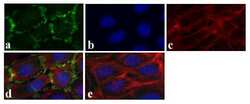
- Experimental details
- Immunofluorescence analysis of Connexin-30 was done on 70% confluent log phase Caco-2 cells. The cells were fixed with 4% paraformaldehyde for 15 minutes, permeabilized with 0.25% Triton X-100 for 10 minutes, and blocked with 5% BSA for 1 hour at room temperature. The cells were labeled with Connexin-30 Rabbit polyclonal Antibody (Product # 71-2200) at 2 µg/mL in 1% BSA and incubated for 3 hours at room temperature and then labeled with Alexa Fluor 488 Goat Anti-Rabbit IgG Secondary Antibody (Product # A-11008) at a dilution of 1:400 for 30 minutes at room temperature (Panel a: green). Nuclei (Panel b: blue) were stained with SlowFade® Gold Antifade Mountant DAPI (Product # S36938). F-actin (Panel c: red) was stained with Alexa Fluor 594 Phalloidin (Product # A12381). Panel d is a merged image showing junctional localization. Panel e shows no primary antibody control. The images were captured at 20X magnification.
- Submitted by
- Invitrogen Antibodies (provider)
- Main image
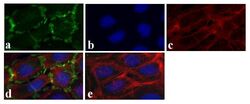
- Experimental details
- Immunofluorescence analysis of Connexin-30 was done on 70% confluent log phase Caco-2 cells. The cells were fixed with 4% paraformaldehyde for 15 minutes, permeabilized with 0.25% Triton X-100 for 10 minutes, and blocked with 5% BSA for 1 hour at room temperature. The cells were labeled with Connexin-30 Rabbit polyclonal Antibody (Product # 71-2200) at 2 µg/mL in 1% BSA and incubated for 3 hours at room temperature and then labeled with Alexa Fluor 488 Goat Anti-Rabbit IgG Secondary Antibody (Product # A-11008) at a dilution of 1:400 for 30 minutes at room temperature (Panel a: green). Nuclei (Panel b: blue) were stained with SlowFade® Gold Antifade Mountant DAPI (Product # S36938). F-actin (Panel c: red) was stained with Alexa Fluor 594 Phalloidin (Product # A12381). Panel d is a merged image showing junctional localization. Panel e shows no primary antibody control. The images were captured at 20X magnification.
Supportive validation
- Submitted by
- Invitrogen Antibodies (provider)
- Main image
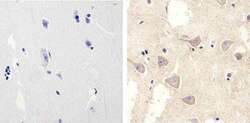
- Experimental details
- Immunohistochemistry analysis of Connexin 30 showing staining in the cytoplasm of paraffin-embedded human brain tissue (right) compared to a negative control without primary antibody (left). To expose target proteins, antigen retrieval was performed using 10mM sodium citrate (pH 6.0), microwaved for 8-15 min. Following antigen retrieval, tissues were blocked in 3% H2O2-methanol for 15 min at room temperature, washed with ddH2O and PBS, and then probed with a Connexin 30 Rabbit Polyclonal Antibody (Product # 71-2200) diluted in 3% BSA-PBS at a dilution of 1:100 overnight at 4°C in a humidified chamber. Tissues were washed extensively in PBST and detection was performed using an HRP-conjugated secondary antibody followed by colorimetric detection using a DAB kit. Tissues were counterstained with hematoxylin and dehydrated with ethanol and xylene to prep for mounting.
Supportive validation
- Submitted by
- Invitrogen Antibodies (provider)
- Main image
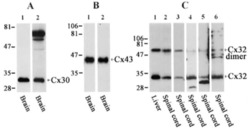
- Experimental details
- NULL
- Submitted by
- Invitrogen Antibodies (provider)
- Main image
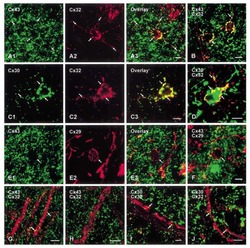
- Experimental details
- NULL
- Submitted by
- Invitrogen Antibodies (provider)
- Main image
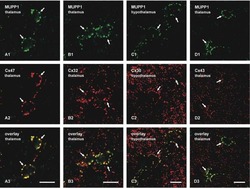
- Experimental details
- NULL
- Submitted by
- Invitrogen Antibodies (provider)
- Main image
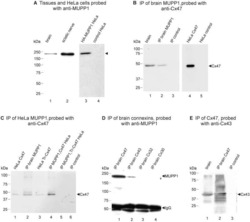
- Experimental details
- NULL
- Submitted by
- Invitrogen Antibodies (provider)
- Main image
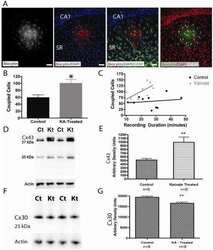
- Experimental details
- NULL
- Submitted by
- Invitrogen Antibodies (provider)
- Main image
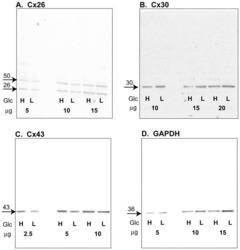
- Experimental details
- NULL
- Submitted by
- Invitrogen Antibodies (provider)
- Main image
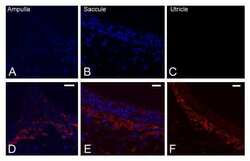
- Experimental details
- NULL
- Submitted by
- Invitrogen Antibodies (provider)
- Main image
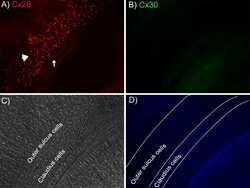
- Experimental details
- NULL
- Submitted by
- Invitrogen Antibodies (provider)
- Main image
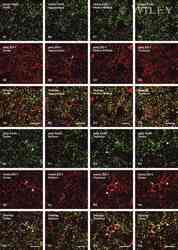
- Experimental details
- NULL
- Submitted by
- Invitrogen Antibodies (provider)
- Main image
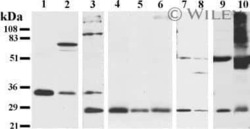
- Experimental details
- NULL
- Submitted by
- Invitrogen Antibodies (provider)
- Main image
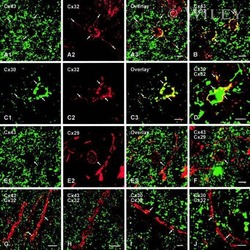
- Experimental details
- NULL
- Submitted by
- Invitrogen Antibodies (provider)
- Main image
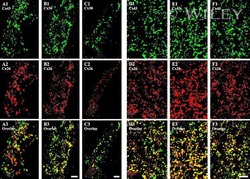
- Experimental details
- NULL
- Submitted by
- Invitrogen Antibodies (provider)
- Main image
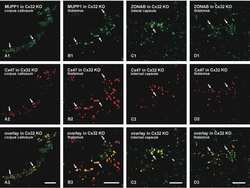
- Experimental details
- NULL
- Submitted by
- Invitrogen Antibodies (provider)
- Main image
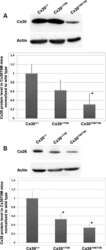
- Experimental details
- Figure 4. Quantitative immunoblot analyses of connexin expression in the adult cochlea. Protein levels were normalized to their corresponding actin bands for quantification. Asterisk in ( A ) indicates a significant reduction in Cx30 in Cx30 T5M/T5M mice compared with Cx30 protein level in wild-type mice. Asterisks in ( B ) indicate a significant reduction in Cx26 in Cx30 T5M/T5M mice compared with Cx26 protein level in wild-type mice.
- Submitted by
- Invitrogen Antibodies (provider)
- Main image
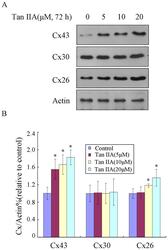
- Experimental details
- Figure 1 Tan IIA treatment of B16 cells results in the upregulation of Cx26 and Cx43 proteins. B16 cells were treated with Tan IIA (0, 5, 10 or 20 uM) for 72 h. (A) Immunoblotting was performed using antibody against Cx26, Cx30 and Cx43. Actin was also tested as a loading control. (B) Relative quantification of the immunoblotting results as calculated by gray scanning (*p
- Submitted by
- Invitrogen Antibodies (provider)
- Main image
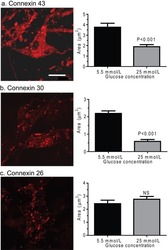
- Experimental details
- Figure 8 Effect of hyperglycaemia on staining of immunoreactive Cx proteins in cultured astrocytes Composite z-stacks of confocal images (left column) of immunostained astrocytes showed a low-intensity background and prominent staining of punctate or vesicular immunoreactive material that appeared to be mainly intracellular. This morphological appearance of immunostaining was evident for Cx43 ( A ), Cx30 ( B ) and Cx26 ( C ) protein in astrocytes grown on coverslips for 14 days in a medium containing 5.5 mmol/l glucose; the scale bar is 12.5 mum and applies to all panels. Areas of these immunostained punctate/vesicular objects (right columns) are means (vertical bars represent 1 S.D.) from the following numbers of objects per group: Cx43, 5.5 mmol/l: n = 752 objects in cells on five coverslips; 25 mmol/l: n = 884 objects in cells on five coverslips; Cx30, 5.5 mmol/l: n = 1099 objects, five coverslips; 25 mmol/l: n = 1177 objects, five coverslips; Cx26, 5.5 mmol/l: n = 514 objects, four coverslips; and 25 mmol/l: n = 974 objects, five coverslips.
- Submitted by
- Invitrogen Antibodies (provider)
- Main image
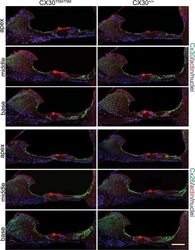
- Experimental details
- Figure 3. Connexin immunoreactity in the adult organ of Corti. Maximal projection rendering of two consecutive midmodiolar confocal optical sections, taken at 1 mum intervals in the indicated cochlear turns of Cx30 T5M/T5M (left) and Cx30 +/+ mice (right) on P30. Cx30 and Cx26 expression was analysed with selective antibodies (green), nuclei were stained with DAPI (blue) and actin filaments with Texas red conjugated phalloidin (red). Scale bar, 50 mum.
- Submitted by
- Invitrogen Antibodies (provider)
- Main image
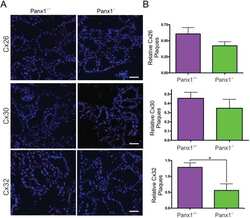
- Experimental details
- Fig 7 Lactating Panx1 -/- mice have fewer Cx32 gap junctions in the mammary gland. (A) Immunofluorescent analysis of mammary gland cryosections during early lactation for Cx26, Cx30 and Cx32 (red) and cytokeratin14 (green) revealed no change in Cx26 and Cx30 gap junctions in knockout mice, while fewer Cx32 gap junctions were observed compared to control mice. Hoescht (blue) denotes nuclei. Scale bar = 50 um. (B) Values represent the mean number of connexin plaques (red) relative to the pixel area of the nuclei (blue), multiplied by a factor of 1x10 2 , per 0.3mm 2 +- S.E.M. N = 5.
- Submitted by
- Invitrogen Antibodies (provider)
- Main image
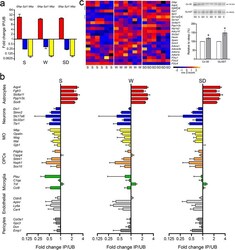
- Experimental details
- Fig. 3 Enrichment analysis of ALDH1L1 - eGFP-L10a IP samples. a qPCR expression (mean +- standard deviation, n = 6, two per group for IP, n = 6, two per group for UB) of the cell-specific marker for astrocytes ( Gfap ) is consistently enriched in the IP RNA across all groups (S, W and SD), whereas the negative controls ( Mbp for oligodendrocytes, Syt1 for neurons) are consistently enriched in the UB samples. b Histograms showing IP/UB ratios expressed in log 2 fold change for S, W and SD samples. In all three experimental groups, the genes identified by [ 25 ] as specific for astrocytes ( red ) are enriched in IP samples, whereas the genes specific for neurons ( blue ), mature oligodendrocytes ( MO , yellow ), oligodendrocyte precursor cells ( OPCs , orange ), microglia ( green ), endothelial cells ( light grey ) and pericytes ( dark grey ) are enriched in S, W and SD UB samples. c Heat diagram ( left ) showing the expression intensities of several common astrocytic genes in each individual S, W and SD mouse. Arrows indicate gjb6 and slc1a3 , the two astrocytic genes selected for Western blot analysis ( right ): Cx-30 (+19 +- 8 %, Mann-Whitney (MW), P = 0.02), GLAST (+49 +- 17 %, MW, P = 0.02) in SD ( n = 4, grey bars ) relative to S ( n = 4, white bars ). Representative bands from S and SD pools ( n = 4 mice per pool) are depicted above each bar for Cx-30 and GLAST
 Explore
Explore Validate
Validate Learn
Learn Western blot
Western blot ELISA
ELISA Immunocytochemistry
Immunocytochemistry